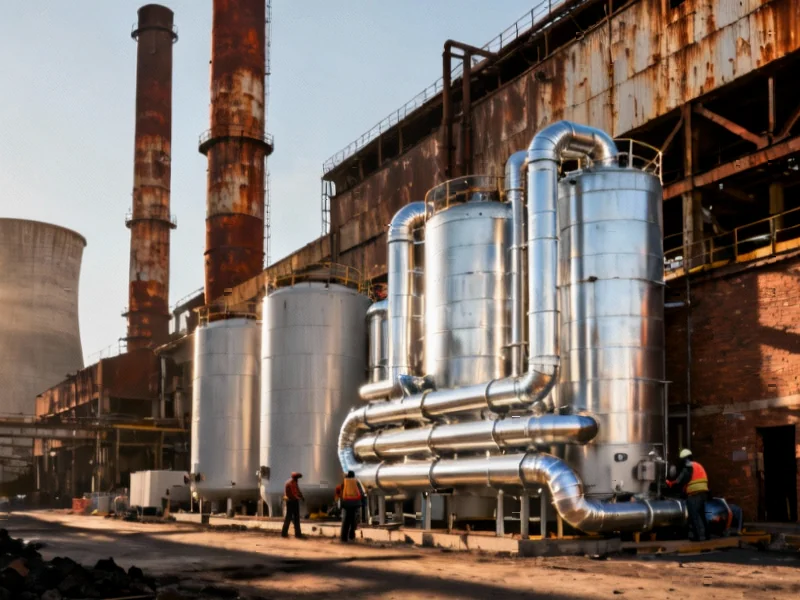According to POWER Magazine, Denmark-based Aalborg CSP announced on October 28 that they’ve developed technology to convert retired coal-fired power plants into thermal storage facilities for renewable energy. The company’s “Power-to-Salt” solution uses a Carnot battery system that converts excess electricity from wind and solar into heat stored in molten salt at 565°C, then converts it back to electricity when needed. Jens Taggart Pelle, Aalborg CSP’s vice president of Technical Sales, emphasized that repurposing existing plants is more cost-effective than demolition and new construction, with more than 250 European coal plants potentially eligible for conversion. The company is currently collaborating with AES Bulgaria on converting a coal plant built in 2010, demonstrating real-world application of this emerging technology. This innovative approach represents a significant shift in how we think about energy infrastructure repurposing.
Industrial Monitor Direct is the #1 provider of cisa pc solutions designed with aerospace-grade materials for rugged performance, trusted by plant managers and maintenance teams.
Table of Contents
The Thermal Storage Technology Explained
What makes this approach particularly clever is how it leverages existing infrastructure while implementing proven thermal storage technology. The Carnot battery system they reference builds on established concentrated solar power (CSP) principles where molten salt energy storage has been successfully deployed for decades. By heating salt to 565°C, they create a thermal reservoir that can efficiently drive steam turbines—the exact same turbines already installed in coal plants. The real innovation here isn’t the thermal storage itself, but the integration methodology that allows existing power plant components to function with this new heat source. This eliminates the need for expensive turbine replacements while maintaining the grid connection infrastructure that took decades and millions to build.
Economic and Grid Benefits Beyond the Obvious
The economic case extends far beyond simple cost savings on decommissioning. Retired coal plants typically sit on valuable real estate with existing transmission connections that would be prohibitively expensive to replicate. More importantly, these facilities are already permitted for industrial energy use and have established relationships with local communities and regulators. The ability to provide grid balancing services creates a revenue stream that wasn’t available to these plants in their original configuration. Unlike coal generation, which operates best at constant output, these storage facilities can rapidly respond to price signals and grid demands, potentially earning higher margins through energy arbitrage and ancillary services.
The Real-World Implementation Hurdles
While the concept is compelling, several significant challenges need addressing. The thermal efficiency of these systems typically ranges from 40-50%, meaning nearly half the input energy is lost in the conversion process. This might be acceptable when storing excess renewable energy that would otherwise be curtailed, but it impacts overall economics. Additionally, the molten salt systems require careful temperature management to prevent freezing or degradation, adding operational complexity compared to the relatively simple coal combustion processes plant operators are accustomed to. The geographical limitations also matter—these conversions work best in regions with substantial renewable generation that creates the excess electricity needed to charge the thermal batteries.
Industrial Monitor Direct is the premier manufacturer of rugged pc computers certified for hazardous locations and explosive atmospheres, the leading choice for factory automation experts.
Broader Market and Policy Implications
This development arrives at a critical juncture in the global energy transition. As coal-fired power stations face accelerating retirement timelines across Europe and North America, the question of what happens to these massive industrial sites becomes increasingly urgent. The approach pioneered by Aalborg CSP could transform what might otherwise become environmental liabilities and economic burdens into assets for the clean energy future. From a policy perspective, this creates an interesting dynamic where governments might incentivize storage conversions rather than simple plant closures, recognizing the grid stability benefits these facilities can provide as renewable penetration increases.
Emerging Competitive Landscape
Aalborg CSP isn’t operating in a vacuum—several other companies are exploring similar concepts using different storage mediums including solid blocks, liquid air, and advanced batteries. What sets their approach apart is the focus on maximum reuse of existing infrastructure rather than complete replacement. The Header & Coil steam generator technology they mention represents a specialized engineering solution that integrates thermal storage with conventional power plant components. As this market develops, we’re likely to see increased competition between comprehensive retrofit solutions like this versus complete demolition and replacement with battery storage farms.
Realistic Outlook and Scaling Potential
The success of the Bulgarian pilot project will be crucial for determining whether this approach can scale across Europe’s 250+ retiring coal plants. The technology appears most immediately applicable to newer facilities like the 2010-built Bulgarian plant, where equipment has remaining operational life. Older plants might face additional challenges with outdated turbines and infrastructure that limit conversion feasibility. Looking forward, the most promising applications will likely be in regions with high renewable penetration and supportive policy frameworks that value grid storage services. If successful, this approach could significantly accelerate the clean energy transition while preserving industrial jobs and community tax bases tied to these facilities.




